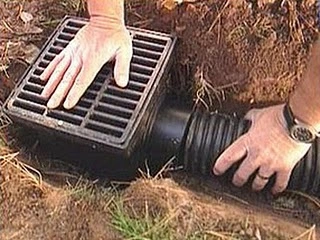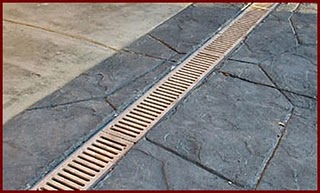French Drain Connected to Curb outlet

Curb outlet with more than 6 inches of fall
Oklahoma Drainage and Sprinkler Repair 405 203 9419 — We provide:
French Drain Installation, Surface Drain Installation, Drainage System Installation
Sprinkler Repair for all aspects of Residential Sprinkler Systems
Emergency Sprinkler Repair Service, AFTER HOURS AND WEEKENDS.
Drainage Systems, French Drains, Surface Drains, Channel Drains, Sump Pumps, Sprinkler Repair, with 26 years of experience.
Just what is a “French Drain?” Many times people incorrectly

- A French Drain can protect your foundation!
use the phrase, “French Drain,” when they mean “Surface Drain” or “Channel Drain.”
A basic French Drain consists of a Perforated Drain Pipe in the bottom of a trench. The French Drain Trench runs through a Problem Drainage Area that needs to be drained. The French Drain Pipe is perforated (Full of Small Holes) and has Neo-Prene Soc around the pipe. This soc helps prevent debris from clogging the French Drain Pipe.

Installing a French Drain in the mud
Standing water can cause a lot of damage to your yard. The above picture was from a French Drain Installation in Oklahoma City.
Many times we wait until things dry out a bit before beginning a French Drain Installation. Some times the water never goes away. So we start digging in standing water and putting the mud in a wheelbarrow. We then haul it to a dump trailer to be hauled away. It isn’t the easiest thing to do.

Setting in the Channel Drain in the cut.

Setting the concrete around the channel drain


Perforated Pipe, Filter , and Liner installed in a drainage trench.
The water started draining away as soon as we dug the Drainage Trench. Once the Pipe and Limestone were installed, it drained away even faster.
The trench liner allows sub surface water to pass through it and reach the French Drain Pipe. The reason it is installed is to maintain the integrity of the drainage trench so it doesn’t collapse over time. It also helps protect the pipe from filling up with mud or sand, clogging the French Drain.
Below is a picture of a French Drain that we had to take out and replace because it had no liner or filter around the Pipe.


result of French Drain Installed Incorrectly



Setting the concrete around the channel drain
The French Drain Pipe shown above has a neo Preen soc around it to prevent sand and debris from clogging the French Drain. The next step is to add the lime stone on top.
Other types of stone can be used as well.


French Drain with colored gravel.’


A French Drain with River Rock
The type of rock that covers a perforated French Drain Pipe can be just about any type of quality gravel or crushed stone. Very small crushed stone or sand is not a good idea, however. The water must be able to flow through the stone to reach the perforated pipe.


Drain Basin Connected into a French Drain and Several Gutters
Servicing Central Oklahoma including: Oklahoma City, Norman, Edmond, Midwest City, Del City, Yukon, Mustang, Moore, Norman, Purcell, Newcastle, Blanchard and surrounding areas.
Just what is a “French Drain?” Many times people incorrectly
use the phrase, “French Drain,” to apply to many different types of Drains that could be used in a Drainage System. The term is widely used and many times incorrectly connected to “Surface Drains,” or “Channel Drains.”
A Surface Drain has a grate that sits on top of a basin. The basin is underground. A Drain Pipe is connected underground to an outlet on the Drain Basin. Storm-Water Drains through the grate into the Drain Basin. Once in the Drain Basin, water travels out of the basin through a Drain Pipe. The Storm-Water continues downhill in an underground Drain Pipe to an exit point.
THIS IS NOT A FRENCH DRAIN!
A Surface Drain may come in many different shapes or sizes. The Drain Grate may be round or square. Here is a picture of a common Surface Drain.
A Channel Drain is a type of Surface Drain and many times is installed in concrete across sidewalks or driveways.
A French Drain is completely different from a Surface Drain. A basic French Drain consists of a Perforated Drain Pipe in the bottom of a trench. The Drain Pipe should have a neoprene sock around the Perforated Drain Pipe. This is to ensure that the Drain Pipe does not become clogged.
The dirt that was taken out to make the trench is hauled away. It is replaced by some type of small stone or gravel depending on what is desired or available. I prefer crushed 1 inch lime stone. It is the most economical option in my area. Pea Gravel or some other type of small stone can work just as well. The lime-stone or gravel is placed in the trench on top of the perforated Drain Pipe and filled all the way to the surface (ground level). In some cases where the French Drain needs to be deep or is being placed in sandy soil, a special trench liner must be placed in the trench before the perforated Drain Pipe or the Gravel are installed. This helps maintain the integrity of the trench over time. It also increases the cost of the French Drain and the amount of time to install it. I install a trench liner in a French Drain about 20% of the time. Most of the time a liner in not needed.
DECORATIVE STONE CAN BE USED TO COVER A FRENCH DRAIN AND THEY LOOK GREAT AND LAST A LIFETIME.


- French Drains Can Look Great!
-
Just what is a “French Drain?” Many times people incorrectly use the phrase, “French Drain,” to apply to many different types of Drains that could be used in a Drainage System. The term is widely used and many times incorrectly connected to “Surface Drains,” or “Channel Drains.”
A Surface Drain has a grate that sits on top of a basin. The basin is underground. A Drain Pipe is connected underground to an outlet on the Drain Basin. Storm-Water Drains through the grate into the Drain Basin. Once in the Drain Basin, water travels out of the basin through a Drain Pipe. The Storm-Water continues downhill in an underground Drain Pipe to an exit point.
THIS IS NOT A FRENCH DRAIN!
A Surface Drain may come in many different shapes or sizes. The Drain Grate may be round or square. Here is a picture of a common Surface Drain.
A Channel Drain is a type of Surface Drain and many times is installed in concrete across sidewalks or driveways.
A French Drain is completely different from a Surface Drain. A basic French Drain consists of a Perforated Drain Pipe in the bottom of a trench. The Drain Pipe should have a neoprene sock around the Perforated Drain Pipe. This is to ensure that the Drain Pipe does not become clogged.
The dirt that was taken out to make the trench is hauled away. It is replaced by some type of small stone or gravel depending on what is desired or available. I prefer crushed 1 inch lime stone. It is the most economical option in my area. Pea Gravel or some other type of small stone can work just as well. The lime-stone or gravel is placed in the trench on top of the perforated Drain Pipe and filled all the way to the surface (ground level). In some cases where the French Drain needs to be deep or is being placed in sandy soil, a special trench liner must be placed in the trench before the perforated Drain Pipe or the Gravel are installed. This helps maintain the integrity of the trench over time. It also increases the cost of the French Drain and the amount of time to install it. I install a trench liner in a French Drain about 20% of the time. Most of the time a liner in not needed


Drain Pipe running to street from French Drain
A French Drain is designed to handle a large volume of water and cover a large area. The Drain is anyplace the trench goes. It has many applications and can be used in many situations. It can be installed by itself or incorporated into a Drainage System with Surface Drains or Gutter Down-Spouts connected to it.The main downfall of a French Drain is, that they, for the most part aren’t very pretty. They don’t look very nice in a yard once they are completed.Depending on the area the French Drain is installed and the type of grass around the French Drain, will dictate whether grass grows over the lime stone. Grass can grow up and through the gravel in the French Drain over time eventually covering the gravel. This is Ok. It won’t have a measurable effect on the performance of the drain.DONT COVER THE GRAVEL IN THE FRENCH DRAIN WITH DIRT. THE FRENCH DRAIN WON’T WORK IF THE TRENCH IS CLOGGED WITH DIRT. DON’T EVEN INSTALL IT IF YOU ARE GOING TO COVER IT UP WITH DIRT. PUTTING DIRT OVER A FRENCH DRAIN IS LIKE PUTTING A CORK BACK IN A BOTTLE.DECORATIVE STONE CAN BE USED TO COVER A FRENCH DRAIN AND THEY LOOK GREAT AND LAST A LIFETIME.






























[…] Setting the concrete around the channel drain […]
[…] example of a complex drainage system would be: A French Drain in the back yard connected to a Surface Drain near a flower bed connected to several gutter […]
[…] example of a complex drainage system would be: A French Drain in the back yard connected to a Surface Drain near a flower bed connected to several gutter […]
[…] such as sewer lines. It is also used for inexpensive Drainage Systems. A Drainage System using Sewer and Drain Pipe is slightly cheaper than ADS. It is rigid and harder to install than ADS. It takes more time to […]
[…] French Drain in Oklahoma City, Norman, Edmond, Moore, Yukon, Mid West City Edmond French Drain, Oklahoma City French Drain, Norman French Drain, Moore French Drain […]
[…] Curb outlet with more than 6 inches of fall […]
[…] example of a complex drainage system would be: A French Drain in the back yard connected to a Surface Drain near a flower bed connected to several gutter […]
[…] Curb outlet with more than 6 inches of fall […]
[…] such as sewer lines. It is also used for inexpensive Drainage Systems. A Drainage System using Sewer and Drain Pipe is slightly cheaper than ADS. It is rigid and harder to install than ADS. It takes more time to […]
[…] kinds of problems. Concrete in driveways, sidewalks, and foundations can be damaged. Prolonged Drainage Problems allow mold to occur along with deterioration to plants, trees, and […]